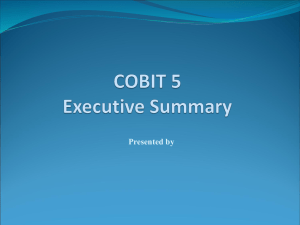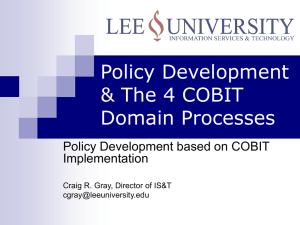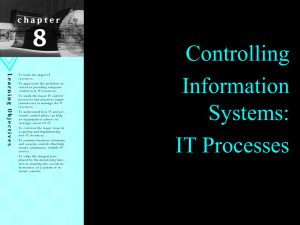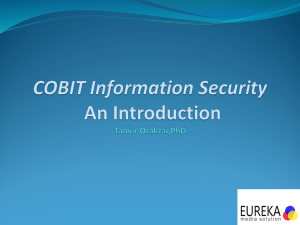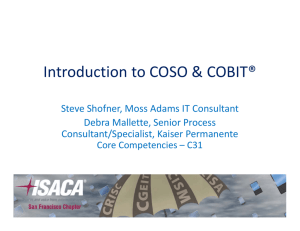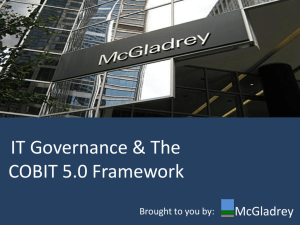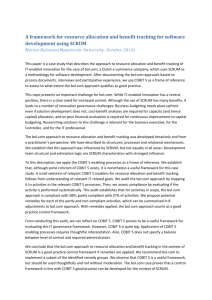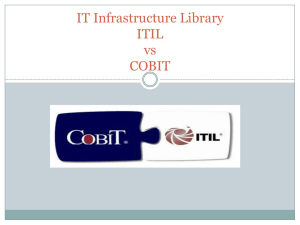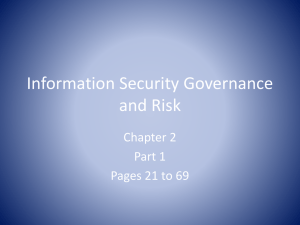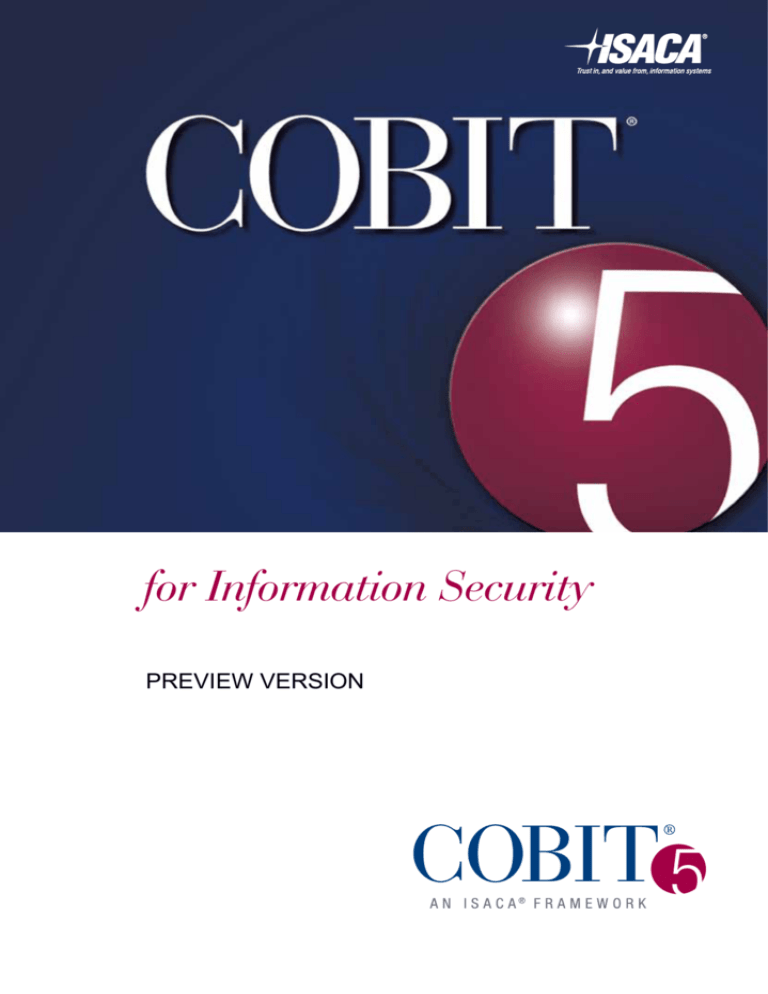
for Information Security
PREVIEW VERSION
The following pages provide a preview of the information
contained in COBIT 5 for Information Security. The publication
provides guidance to help IT and Security professionals
understand, utilize, implement and direct important informationsecurity related activities and make more informed decisions.
COBIT 5 for Information Security is a major strategic evolution of
COBIT 5—the only business framework for the governance and
management of enterprise IT. This evolutionary version
incorporates the latest thinking in enterprise governance and
management techniques, and provides globally accepted
principles, practices, analytical tools and models to help increase
the trust in, and value from, information systems.
To purchase COBIT 5 for Information Security, visit
www.isaca.org/cobit5info-sec
Not a member? Learn the value of ISACA membership.
Additional information is available at
www.isaca.org/membervalue.
for Information
Security
ISACA®
With more than 100,000 constituents in 180 countries, ISACA (www.isaca.org) is a leading global provider of knowledge,
certifications, community, advocacy and education on information systems (IS) assurance and security, enterprise
governance and management of IT, and IT-related risk and compliance. Founded in 1969, the nonprofit, independent
ISACA hosts international conferences, publishes the ISACA® Journal, and develops international IS auditing and control
standards, which help its constituents ensure trust in, and value from, information systems. It also advances and attests
IT skills and knowledge through the globally respected Certified Information Systems Auditor® (CISA®), Certified
Information Security Manager® (CISM®), Certified in the Governance of Enterprise IT® (CGEIT®) and Certified in Risk
and Information Systems ControlTM (CRISCTM) designations.
ISACA continually updates and expands the practical guidance and product family based on the COBIT framework.
COBIT helps IT professionals and enterprise leaders fulfill their IT governance and management responsibilities,
particularly in the areas of assurance, security, risk and control, and deliver value to the business.
Disclaimer
ISACA has designed this publication, COBIT® 5 for Information Security (the ‘Work’), primarily as an educational
resource for security professionals. ISACA makes no claim that use of any of the Work will assure a successful outcome.
The Work should not be considered inclusive of all proper information, procedures and tests or exclusive of other
information, procedures and tests that are reasonably directed to obtaining the same results. In determining the propriety
of any specific information, procedure or test, security professionals should apply their own professional judgement to the
specific circumstances presented by the particular systems or information technology environment.
Copyright
© 2012 ISACA. All rights reserved. For usage guidelines, see www.isaca.org/COBITuse.
ISACA
3701 Algonquin Road, Suite 1010
Rolling Meadows, IL 60008 USA
Phone: +1.847.253.1545
Fax: +1.847.253.1443
Email: info@isaca.org
Web site: www.isaca.org
Feedback: www.isaca.org/cobit
Participate in the ISACA Knowledge Center: www.isaca.org/knowledge-center
Follow ISACA on Twitter: https://twitter.com/ISACANews
Join the COBIT conversation on Twitter: #COBIT
Join ISACA on LinkedIn: ISACA (Official), http://linkd.in/ISACAOfficial
Like ISACA on Facebook: www.facebook.com/ISACAHQ
COBIT® 5 for Information Security
ISBN 978-1-60420-255-7
Printed in the United States of America
1
2
Table of Contents
Table of Contents
List of Figures.................................................................................................................................................................................... 11
Executive Summary.......................................................................................................................................................................... 13
Introduction..................................................................................................................................................................................... 13
Drivers............................................................................................................................................................................................. 13
Benefits........................................................................................................................................................................................... 15
Target Audience.............................................................................................................................................................................. 16
Conventions Used and Overview................................................................................................................................................... 16
Section I. Information Security............................................................................................................................................. 19
Chapter 1. Information Security Defined....................................................................................................................................... 19
Chapter 2. COBIT 5 Principles....................................................................................................................................................... 21
2.1 Overview................................................................................................................................................................................... 21
2.2 Principle 1. Meeting Stakeholder Needs.................................................................................................................................. 21
2.3 Principle 2. Covering the Enterprise End-to-end..................................................................................................................... 22
2.4 Principle 3. Applying a Single, Integrated Framework............................................................................................................ 22
2.5 Principle 4. Enabling a Holistic Approach............................................................................................................................... 23
2.6 Principle 5. Separating Governance From Management......................................................................................................... 23
Section II. Using COBIT 5 Enablers for Implementing Information Security in Practice........................ 25
Chapter 1. Introduction.................................................................................................................................................................... 25
1.1 The Generic Enabler Model...................................................................................................................................................... 25
1.2 Enabler Performance Management.......................................................................................................................................... 26
1.3 COBIT 5 for Information Security and Enablers...................................................................................................................... 26
Chapter 2. Enabler: Principles, Policies and Frameworks.......................................................................................................... 27
2.1 Principles, Policies and Framework Model.............................................................................................................................. 27
2.2 Information Security Principles................................................................................................................................................ 29
2.3 Information Security Policies................................................................................................................................................... 29
2.4 Adapting Policies to the Enterprise’s Environment.................................................................................................................. 30
2.5 Policy Life Cycle...................................................................................................................................................................... 31
Chapter 3. Enabler: Processes......................................................................................................................................................... 33
3.1 The Process Model.................................................................................................................................................................... 33
3.2 Governance and Management Processes................................................................................................................................. 34
3.3 Information Security Governance and Management Processes..............................................................................................34
3.4 Linking Processes to Other Enablers........................................................................................................................................ 35
Chapter 4. Enabler: Organisational Structures............................................................................................................................ 37
4.1 Organisational Structures Model.............................................................................................................................................. 37
4.2 Information Security Roles and Structures..............................................................................................................................38
4.3 Accountability Over Information Security............................................................................................................................... 39
Chapter 5. Enabler: Culture, Ethics and Behaviour.................................................................................................................... 41
5.1 Culture Model........................................................................................................................................................................... 41
5.2 Culture Life Cycle.................................................................................................................................................................... 42
5.3 Leadership and Champions...................................................................................................................................................... 42
5.4 Desirable Behaviour................................................................................................................................................................. 43
Chapter 6. Enabler: Information.................................................................................................................................................... 45
6.1 Information Model.................................................................................................................................................................... 45
6.2 Information Types..................................................................................................................................................................... 46
6.3 Information Stakeholders......................................................................................................................................................... 46
6.4 Information Life Cycle............................................................................................................................................................. 47
Chapter 7. Enabler: Services, Infrastructure and Applications.................................................................................................. 49
7.1 Services, Infrastructure and Applications Model.....................................................................................................................49
7.2 Information Security Services, Infrastructure and Applications.............................................................................................50
Chapter 8. Enabler: People, Skills and Competencies................................................................................................................. 51
8.1 People, Skills and Competencies Model.................................................................................................................................. 51
8.2 Information Security-related Skills and Competencies........................................................................................................... 52
7
for Information
Security
Section III. Adapting COBIT 5 for Information Security to the Enterprise Environment........................... 53
Chapter 1. Introduction.................................................................................................................................................................... 53
Chapter 2. Implementing Information Security Initiatives.......................................................................................................... 55
2.1. Considering the Enterprise’s Information Security Context................................................................................................... 55
2.2. Creating the Appropriate Environment................................................................................................................................... 55
2.3. Recognising Pain Points and Trigger Events........................................................................................................................... 56
2.4. Enabling Change...................................................................................................................................................................... 56
2.5. A Life Cycle Approach............................................................................................................................................................ 57
Chapter 3. U
sing COBIT 5 for Information Security to Connect Other Frameworks, Models,
Good Practices and Standards..................................................................................................................................... 59
Appendices
Appendix A. Detailed Guidance: Principles, Policies and Frameworks Enabler...................................................................... 61
A.1 Information Security Principles............................................................................................................................................... 61
A.2 Information Security Policy..................................................................................................................................................... 63
A.3 Specific Information Security Policies Driven by the Information Security Function.......................................................... 63
A.4 Specific Information Security Policies Driven by Other Functions Within the Enterprise.................................................. 65
Appendix B. Detailed Guidance: Processes Enabler.................................................................................................................... 67
B.1 Evaluate, Direct and Monitor (EDM)...................................................................................................................................... 69
B.2 Align, Plan and Organise (APO).............................................................................................................................................. 81
B.3 Build, Acquire and Implement (BAI)....................................................................................................................................115
B.4 Deliver, Service and Support (DSS)......................................................................................................................................141
B.5 Monitor, Evaluate and Assess (MEA)...................................................................................................................................159
Appendix C. Detailed Guidance: Organisational Structures Enabler.....................................................................................169
C.1 Chief Information Security Officer.......................................................................................................................................169
C.2 Information Security Steering Committee............................................................................................................................171
C.3 Information Security Manager..............................................................................................................................................172
C.4 Enterprise Risk Management Committee.............................................................................................................................174
C.5 Information Custodians/Business Owners............................................................................................................................174
Appendix D. Detailed Guidance: Culture, Ethics and Behaviour Enabler.............................................................................175
D.1 Behaviours..............................................................................................................................................................................175
D.2 Leadership..............................................................................................................................................................................176
Appendix E. Detailed Guidance: Information Enabler.............................................................................................................179
E.1 Information Security Stakeholders Template.........................................................................................................................179
E.2 Information Security Strategy................................................................................................................................................181
E.3 Information Security Budget..................................................................................................................................................182
E.4 Information Security Plan......................................................................................................................................................183
E.5 Policies....................................................................................................................................................................................184
E.6 Information Security Requirements.......................................................................................................................................184
E.7 Awareness Material................................................................................................................................................................184
E.8 Information Security Review Reports...................................................................................................................................185
E.9 Information Security Dashboard............................................................................................................................................186
Appendix F. Detailed Guidance: Services, Infrastructure and Applications Enabler............................................................189
F.1 Security Architecture..............................................................................................................................................................189
F.2 Security Awareness.................................................................................................................................................................191
F.3 Secure Development...............................................................................................................................................................192
F.4 Security Assessments..............................................................................................................................................................192
F.5 Adequately Secured and Configured Systems, Aligned With Security Requirements and Security Architecture...............193
F.6 User Access and Access Rights in Line With Business Requirements..................................................................................194
F.7 Adequate Protection Against Malware, External Attacks and Intrusion Attempts................................................................196
F.8 Adequate Incident Response...................................................................................................................................................197
F.9 Security Testing.......................................................................................................................................................................198
F.10 Monitoring and Alert Services for Security-related Events.................................................................................................199
8
Table of Contents
Appendix G. Detailed Guidance: People, Skills and Competencies Enabler..........................................................................201
G.1 Information Security Governance.........................................................................................................................................201
G.2 Information Security Strategy Formulation..........................................................................................................................202
G.3 Information Risk Management..............................................................................................................................................203
G.4 Information Security Architecture Development..................................................................................................................203
G.5 Information Security Operations...........................................................................................................................................204
G.6 Information Assessment and Testing and Compliance.........................................................................................................205
Appendix H. Detailed Mappings....................................................................................................................................................207
Acronyms..........................................................................................................................................................................................215
Glossary............................................................................................................................................................................................217
9
List of Figures
List of Figures
figures
Figure 1—COBIT 5 Product Family........................................................................................................................................ 13
Figure 2—COBIT 5 as it Relates to Information Security...................................................................................................... 14
Figure 3—COBIT 5 for Information Security Capabilities..................................................................................................... 16
Figure 4—COBIT 5 Principles................................................................................................................................................ 21
Figure 5—COBIT 5 Goals Cascade Overview....................................................................................................................... 22
Figure 6—COBIT 5 Enabler: Systemic Model With Interacting Enablers............................................................................ 23
Figure 7—COBIT 5 Process Reference Model....................................................................................................................... 24
Figure 8—COBIT 5 Enablers: Generic.................................................................................................................................. 25
Figure 9—COBIT 5 Enabler: Principles, Policies and Frameworks...................................................................................... 27
Figure 10—Policy Framework................................................................................................................................................. 28
Figure 11—COBIT 5 Enabler: Processes............................................................................................................................... 33
Figure 12—COBIT 5 Enabler: Organisational Structures..................................................................................................... 37
Figure 13—Information Security-specific Roles/Structures................................................................................................... 38
Figure 14—Advantages and Disadvantages of Potential Paths for Information Security Reporting..................................... 39
Figure 15—COBIT 5 Enabler: Culture, Ethics and Behaviour.............................................................................................. 41
Figure 16—COBIT 5 Enabler: Information........................................................................................................................... 45
Figure 17—Example Stakeholders for Information Security-related Information (Small/Medium Enterprise)................... 47
Figure 18—COBIT 5 Enabler: Services, Infrastructure and Applications............................................................................ 49
Figure 19—COBIT 5 Enabler: People, Skills and Competencies.......................................................................................... 51
Figure 20—Information Security Skills/Competencies.......................................................................................................... 52
Figure 21—The Seven Phases of the Implementation Life Cycle.......................................................................................... 57
Figure 22—Information Security Principles............................................................................................................................ 61
Figure 23—Specific Information Security Policies Driven by Other Functions Within the Organisation: Scope............... 65
Figure 24—COBIT 5 Process Reference Model..................................................................................................................... 67
Figure 25—CISO: Mandate, Operating Principles, Span of Control and Authority Level.................................................169
Figure 26—CISO: High-level RACI Chart With Key Practices..........................................................................................170
Figure 27—CISO: Inputs and Outputs.................................................................................................................................170
Figure 28—ISSC: Composition............................................................................................................................................171
Figure 29—ISSC: Mandate, Operating Principles, Span of Control and Authority Level..................................................171
Figure 30—ISSC: High-level RACI Chart...........................................................................................................................172
Figure 31—ISSC: Inputs and Outputs..................................................................................................................................172
Figure 32—ISM: Mandate, Operating Principles, Span of Control and Authority Level...................................................172
Figure 33—ISM: High-level RACI Chart............................................................................................................................173
Figure 34—ISM: Inputs and Outputs...................................................................................................................................173
Figure 35—ERM Committee: Composition.........................................................................................................................174
Figure 36—ERM Committee: High-level RACI Chart........................................................................................................174
Figure 37—Information Custodians/Business Owners: High-level RACI Chart................................................................174
Figure 38—Information Related to Stakeholders for Information Security Template.........................................................180
Figure 39—Plan Services: Description of the Service Capability.......................................................................................189
Figure 40—Plan Services: Attributes....................................................................................................................................190
Figure 41—Plan Services: Goals..........................................................................................................................................190
Figure 42—Security Awareness Services: Description of the Service Capability...............................................................191
Figure 43—Security Awareness Services: Attributes...........................................................................................................191
Figure 44—Security Awareness Services: Goals..................................................................................................................191
Figure 45—Secure Development Services: Description of the Service Capability............................................................192
Figure 46—Secure Development Services: Attributes.........................................................................................................192
Figure 47—Secure Development Services: Goals...............................................................................................................192
Figure 48—Security Assessment Services: Description of the Service Capability.............................................................192
Figure 49—Security Assessment Services: Attributes.........................................................................................................193
Figure 50—Security Assessment Services: Goals................................................................................................................193
Figure 51—Adequately Secured Systems Services: Description of the Service Capability...............................................193
Figure 52—Adequately Secured Systems Services: Attributes...........................................................................................194
Figure 53—Adequately Secured Systems Services: Goals..................................................................................................194
Figure 54—User Access and Access Rights Services: Description of the Service Capability...........................................194
Figure 55—User Access and Access Rights Services: Attributes........................................................................................195
Figure 56—User Access and Access Rights Services: Goals...............................................................................................196
Figure 57—Protection Against Malware and Attacks Services: Description of the Service Capability.............................196
11
for Information
Security
Figure 58—Protection Against Malware and Attacks Services: Attributes.........................................................................197
Figure 59—Protection Against Malware and Attacks Services: Goals................................................................................197
Figure 60—Incident Response Services: Description of the Service Capability................................................................197
Figure 61—Incident Response Services: Attributes.............................................................................................................198
Figure 62—Incident Response Services: Goals...................................................................................................................198
Figure 63—Security Testing Services: Description of the Service Capability....................................................................198
Figure 64—Security Testing Services: Attributes.................................................................................................................198
Figure 65—Security Testing Services: Goals.......................................................................................................................199
Figure 66—Information Security Monitoring/Improvement Services: Description of the Service Capability..................199
Figure 67—Information Security Monitoring/Improvement Services: Attributes..............................................................199
Figure 68—Information Security Monitoring/Improvement Services: Goals.....................................................................200
Figure 69—Information Security Governance: Experience, Education and Qualifications...............................................201
Figure 70—Information Security Governance: Knowledge, Technical Skills and Behavioural Skills...............................201
Figure 71—Information Security Strategy Formulation: Experience, Education and Qualifications................................202
Figure 72—Information Security Strategy Formulation: Knowledge, Technical Skills and Behavioural Skills................202
Figure 73—Information Security Strategy Formulation: Related Role/Structure...............................................................202
Figure 74—Information Risk Management: Experience, Education and Qualifications...................................................203
Figure 75—Information Risk Management: Knowledge, Technical Skills and Behavioural Skills...................................203
Figure 76—Information Security Architecture Development: Experience, Education and Qualifications........................203
Figure 77—Information Security Architecture Development: Knowledge, Technical Skills and Behavioural Skills.......204
Figure 78—Information Security Architecture Development: Related Role/Structure.......................................................204
Figure 79—Information Security Operations: Experience, Education and Qualifications.................................................204
Figure 80—Information Security Operations: Knowledge, Technical Skills and Behavioural Skills.................................205
Figure 81—Information Security Operations: Related Role/Structure................................................................................205
Figure 82—Information Security Auditing and Compliance: Experience, Education and Qualifications.........................205
Figure 83—Information Security Auditing and Compliance: Knowledge, Technical Skills and Behavioural Skills.........205
Figure 84—Mapping of COBIT 5 for Information Security to Related Standards...............................................................208
12
Executive Summary
Executive Summary
Introduction
Information is a key resource for all enterprises and, from the time information is created to the moment it is destroyed,
technology plays a significant role. Technology is increasingly advanced and has become pervasive in enterprises and the
social, public and business environments.
COBIT 5 provides a comprehensive framework that assists enterprises in achieving their objectives for the governance and
management of enterprise IT. Simply stated, it helps enterprises create optimal value from information technology (IT) by
maintaining a balance between realising benefits and optimising risk levels and resource use. COBIT 5 enables IT to be
governed and managed in a holistic manner for the entire enterprise, taking into account the full end-to-end business and
IT functional areas of responsibility, considering the IT-related interests of internal and external stakeholders.
COBIT 5 for Information Security, highlighted in figure 1, builds on the COBIT 5 framework in that it focusses on
information security and provides more detailed and more practical guidance for information security professionals and
other interested parties at all levels of the enterprise (see figure 2).
Figure 1—COBIT 5 Product Family
COBIT® 5
COBIT 5 Enabler Guides
COBIT® 5:
Enabling Processes
COBIT® 5:
Enabling Information
Other Enabler
Guides
COBIT 5 Professional Guides
COBIT® 5 Implementation
COBIT® 5
for Information
Security
COBIT® 5
for Assurance
COBIT® 5
for Risk
Other Professional
Guides
COBIT 5 Online Collaborative Environment
Drivers
In COBIT 5, the processes APO13 Manage security, DSS04 Manage continuity and DSS05 Manage security services
provide basic guidance on how to define, operate and monitor a system for general security management. However,
the assumption made in this publication is that information security is pervasive throughout the entire enterprise, with
information security aspects in every activity and process performed. Therefore, COBIT 5 for Information Security
provides the next generation of ISACA’s guidance on the enterprise governance and management of information security.
The major drivers for the development of COBIT 5 for Information Security include:
• The need to describe information security in an enterprise context including:
– The full end-to-end business and IT functional responsibilities of information security
– All aspects that lead to effective governance and management of information security, such as organisational structures,
policies and culture
– The relationship and link of information security to enterprise objectives
• An ever-increasing need for the enterprise to:
– Maintain information risk at an acceptable level and to protect information against unauthorised disclosure,
unauthorised or inadvertent modifications, and possible intrusions.
– Ensure that services and systems are continuously available to internal and external stakeholders, leading to user
satisfaction with IT engagement and services.
– Comply with the growing number of relevant laws and regulations as well as contractual requirements and internal
policies on information and systems security and protection, and provide transparency on the level of compliance.
– Achieve all of the above while containing the cost of IT services and technology protection.
13
APO09 Manage
Service
Agreements
APO02 Manage
Strategy
BAI09 Manage
Assets
BAI02 Manage
Requirements
Definition
DSS05 Manage
Security
Services
DSS04 Manage
Continuity
DSS06 Manage
Business
Process Controls
Processes for Management of Enterprise IT
DSS03 Manage
Problems
BAI06 Manage
Changes
APO13 Manage
Security
APO06 Manage
Budget and Costs
BAI07 Manage
Change
Acceptance and
Transitioning
APO07 Manage
Human Resources
EDM05 Ensure
Stakeholder
Transparency
Section II, Chapter 3
Detailed Guidance: Appendix B
DSS02 Manage
Service Requests
and Incidents
BAI05 Manage
Organisational
Change
Enablement
BAI04 Manage
Availability
and Capacity
BAI03 Manage
Solutions
Identification
and Build
BAI010 Manage
Configuration
APO12 Manage
Risk
APO11 Manage
Quality
ow
la
5
cu
H ow
te
do
re ?
p
th e
e
we
ge
t
4
I d e n t i fy r o l e
pl ay er s
De a
t
s
m
Co o
Wh
fi n
3
De
er
Section III
W h a t n e eds to be d on e?
P la n p r o gr a m m e
en
en t
ts
Recog
need nise
act to
Establ
is
to ch h des
ang ire
e
B u il d
im prove m ent
r
nito
Mo and
ate
alu
ev
re th
ed
r
1 What a
ive
Initiat
rs?
e pr
ogr
am
me
MEA03 Monitor,
Evaluate and Assess
Compliance With
External Requirements
MEA02 Monitor,
Evaluate and Assess
the System of Internal
Control
MEA01 Monitor,
Evaluate and Assess
Performance and
Conformance
Monitor, Evaluate
and Assess
(inner ring)
• Programme management
(outer ring)
• Change enablement
(middle ring)
• Continual improvement life cycle
Information Security-specific
Information Types
e
going?
n
stai
Su
Operate
and
measur
e
at
er
Op d us
an
• Information security strategy
• Information security budget
• Information security plan
• Policies
• Information security requirements
• Awareness material
• Information security review reports
• Information risk profile
• Information security dashboard
Section II, Chapter 6
Detailed Guidance: Appendix E
n
Embed n
approach ew
es
ive
ect
eff
m
mentu
e mo
p th
kee
we
viewness
do
Re
fi
rg n e
ta e t
te
7H
Adapting COBIT 5 for Information Security
to the Environment
DSS01 Manage
Operations
Deliver, Service and Support
BAI08 Manage
Knowledge
BAI01 Manage
Programmes and
Projects
APO05 Manage
Portfolio
APO04 Manage
Innovation
EDM04 Ensure
Resource
Optimisation
APO10 Manage
Suppliers
m
ut u n i
co c a
me te
Realise ben
efits
Ex e
er
e?
re?
EDM03 Ensure
Risk Optimisation
p
ma
le m
I m p ro ve m
imp
to b
ss
Asseent
curr te
sta
ant
ementation
impl
rm team
Fo
oa
d
re we now?
here a
ew
6 Did we get the
APO03 Manage
Enterprise
Architecture
EDM02 Ensure
Benefits Delivery
Build, Acquire and Implement
APO08 Manage
Relationships
APO01 Manage
the IT Management
Framework
Align, Plan and Organise
EDM01 Ensure
Governance
Framework Setting
and Maintenance
Evaluate, Direct and Monitor
Processes for Governance of Enterprise IT
ms and
probleities
ine
un
Def opport
ow
14
2W
ed
Culture, Ethics
and Behaviour
Generic Information
Security Standards,
Frameworks and
Models
Section II, Chapter 8
Detailed Guidance: Appendix G
• Information security govenance
• Information security strategy formulation
• Information risk management
• Information security architecture development
• Information security operations
• Information assessment and testing and compliance
Information Security-specific
People, Skills and Competencies
Information Security Requirements
and Documentation
Information Security Procedures
Information Security-specific
Services, Infrastructure and Applications
• Provide a security architecture.
• Provide security awareness.
• Provide secure development.
• Provide security assessments.
• Provide adequately secured and configured systems.
• Provide user access and access rights.
• Provide adequate protection against external attacks and intrusion attempts.
• Provide adequate incident response.
• Provide security testing.
• Provide monitoring and alert services.
Section II, Chapter 7
Detailed Guidance: Appendix F
People, Skills
and
Competencies
Specific Information Security Policies
Information Security Policy
Input
Mandatory
Information
Security Standards,
Frameworks
and Models
Policy Framework
Information Security Principles
Information Security-specific
Principles, Policies and Frameworks
Section II, Chapter 2
Detailed Guidance: Appendix A
Services,
Infrastructure and
Applications
Principles, Policies and Frameworks
Organisational
Structures
RESOURCES
Information
Processes
COBIT 5 ENABLERS
Section II, Chapter 5
Detailed Guidance: Appendix D
• Information security is practiced in daily operations.
• People respect the policies and principles.
• People are provided with sufficient and detailed guidance,
and are encouraged to participate in and challenge the
current situation.
• Everyone is accountable for protection.
• Stakeholders identify and respond to threats to the enterprise.
• Management proactively supports and anticipates innovations.
• Business management engages in continuous
cross-functional collaboration.
• Executive management recognises the business value.
• Chief information security officer (CISO)
• Information security steering committee (ISSC)
• Information security manager (ISM)
• Other related roles and structures
Section II, Chapter 4
Detailed Guidance: Appendix C
Desired Information Security-specific
Culture, Ethics and Behaviour
Information Security-specific
Organisational Structures
Figure 2—COBIT 5 as it Relates to Information Security
for Information
Security
Executive Summary
­• The need to connect to, and, where relevant, align with, other major frameworks and standards in the marketplace. The
(non-exhaustive) mapping (appendix H) will help stakeholders understand how various frameworks, good practices
and standards are positioned relative to each other and how they can be used together and complement each other
under the umbrella of COBIT 5 for Information Security.
• The need to link together all major ISACA research, frameworks and guidance, with a primary focus on the
Business Model for Information Security (BMIS) and COBIT, but also considering Val IT, Risk IT, the IT Assurance
Framework (ITAF), the publication titled Board Briefing on IT Governance and the Taking Governance Forward
(TGF) resource.
In addition to these major drivers for the development of COBIT 5 for Information Security is the fact that information
security is essential in the day-to-day operations of enterprises. Breaches in information security can lead to a substantial
impact within the enterprise through, for example, financial or operational damages. In addition, the enterprise can be
exposed to external impacts such as reputational or legal risk, which can jeopardise customer or employee relations or even
endanger the survival of the enterprise.
The need for stronger, better and more systematic approaches for information security is illustrated in the following examples:
• A national critical infrastructure depends on information systems, and successful intrusions can result in a significant
impact to economies or human safety.
• Non-public financial information can be used for economic gain.
• Disclosure of confidential information can generate embarrassment to enterprises, cause damage to reputations or
jeopardise business relations.
• Intrusion in commercial networks, for example, to obtain credit card or other payment-related data, can lead to
substantial reputational and financial damage due to fines, as well as increased scrutiny from regulatory bodies.
• Industrial espionage can enable trade secrets to be imitated and increase competition for manufacturing enterprises.
• Leakage of national or military intelligence can result in damage to political relationships.
• Personal data leaks can result in financial loss and unnecessary efforts to rebuild an individual’s financial reputation.
• Significant unplanned costs (both financial and operational) related to containing, investigating and remediating
security breaches can impact any enterprise that has suffered a breach.
Benefits
Using COBIT 5 for Information Security brings a number of information security-related capabilities to the enterprise,
which can result in a number of enterprise benefits such as:
• Reduced complexity and increased cost-effectiveness due to improved and easier integration of information security
standards, good practices and/or sector-specific guidelines
• Increased user satisfaction with information security arrangements and outcomes
• Improved integration of information security in the enterprise
• Informed risk decisions and risk awareness
• Improved prevention, detection and recovery
• Reduced (impact of) information security incidents
• Enhanced support for innovation and competitiveness
• Improved management of costs related to the information security function
• Better understanding of information security
These benefits are obtained by leveraging the COBIT 5 for Information Security capabilities shown in figure 3.
15
for Information
Security
Figure 3—COBIT 5 for Information Security Capabilities
COBIT 5 for Information
Security Capability
Up-to-date view on governance
Description
COBIT 5 for Information Security provides the most up-to-date view on information security governance and
management through alignment with COBIT 5, International Organization for Standardization (ISO)/International
Electrotechnical Commission (IEC) 38500 and other IT governance initiatives. During the development of COBIT 5 for
Information Security, the most important guidance and standards were analysed. COBIT 5 for Information Security
aligns with other major frameworks, standards and models in the marketplace, such as the ISO/IEC 27000 series,
the Information Security Forum (ISF) Standard of Good Practice, and BMIS.
Additionally, ISACA’s information security governance offerings, Information Security Governance: Guidance
for Information Security Managers and Information Security Governance: Guidance for Boards of Directors and
Executive Management, 2nd Edition were analysed during the development of COBIT 5 for Information Security.
Clear distinction between
governance and management
COBIT 5 clarifies the roles of governance and management and provides a clear distinction between them, with a
revised process model reflecting this distinction and showing how they relate to each other.
End-to-end view
COBIT 5 for Information Security is a process model that integrates both business and IT functional responsibilities.
It provides a clear distinction between information security governance and information security management
practices, outlining responsibilities at various levels of the enterprise, encompassing all process steps from the
beginning to the end.
Holistic guidance
The COBIT 5 for Information Security framework brings together comprehensive and holistic guidance on
information security. Holistic means that attention is paid not only to processes, but to all enablers, including
information, structures, culture, policies and their interdependence.
COBIT 5 for Information Security is based on the COBIT 5 framework, from which all information security-relevant
information has been filtered and complemented with more detailed and specific guidance, therefore ensuring consistency
with the COBIT 5 product architecture. COBIT 5 starts from stakeholder expectations and concerns related to enterprise
IT. All guidance can be related back to stakeholder issues, and thus information security assists to support the mission of
the business and achievement of business goals.
Target Audience
COBIT 5 for Information Security is intended for all stakeholders of information security. Chief information security
officers (CISOs), information security managers (ISMs) and other information security professionals are the most obvious
target audience. However, information security is the responsibility of all stakeholders of the enterprise, including all staff
members, and other stakeholders, including third parties. Therefore, this publication may be of interest to all stakeholders
in the enterprise.
Conventions Used and Overview
COBIT 5 for Information Security refers to a number of enablers such as roles and job titles, committees and boards,
processes, and policies. The unique characteristics of each enterprise will cause these enablers to be used in many different
ways to provide information security in an optimal manner. COBIT 5 for Information Security uses guidance and examples
to provide a pervasive view that explains each concept of COBIT 5 from an information security perspective.
To guide the reader through the vast collection of information, COBIT 5 for Information Security follows a set structure
consisting of three sections and eight appendices.
Each section contains several chapters. Within a chapter, as required, signposting is used to guide the reader throughout the
explanation. In addition, blue and grey information boxes are used:
• A blue box calls out attention points relevant for information security.
• A grey box highlights material that is given to link the information with other relevant items. The sections also refer to
the appendices for more specific information.
16
Executive Summary
Each section and its interconnections with other sections is described as follows:
• Section I—Elaborates on information security and describes briefly how the COBIT 5 architecture can be tailored to
information security-specific needs. This section provides a conceptual baseline that is followed throughout the rest of
the publication.
• Section II—Elaborates on the use of COBIT 5 enablers for implementing information security. Governance
of enterprise IT is systemic and supported by a set of enablers. In this section, the concept of the security-specific
enablers is introduced and explained using practical examples. Detailed guidance regarding these enablers is provided
in the appendices.
• Section III—Elaborates on how to adapt COBIT 5 for Information Security to the enterprise environment. This
section contains guidance on how information security initiatives can be implemented and contains a mapping with
other standards and frameworks in the area of information security and COBIT 5 for Information Security.
The appendices contain detailed guidance based on the enablers introduced in section II:
• Appendix A—Detailed guidance regarding the principles, policies and frameworks enabler
• Appendix B—Detailed guidance regarding the processes enabler
• Appendix C—Detailed guidance regarding the organisational structures enabler
• Appendix D—Detailed guidance regarding the culture, ethics and behaviour enabler
• Appendix E—Detailed guidance regarding the information enabler
• Appendix F—Detailed guidance regarding the services, infrastructure and applications enabler
• Appendix G—Detailed guidance regarding the people, skills and competencies enabler
• Appendix H—Detailed mappings of COBIT 5 for Information Security to other information security standards
The Acronyms and Glossary sections clarify the abbreviations and terms used exclusively in this publication. For
standardised terms, please refer to the ISACA Glossary of Terms located at www.isaca.org/Glossary.
17
Section I, Chapter 1
Information Security Defined
Section I. Information Security
Chapter 1
Information Security Defined
ISACA defines information security as something that:
Ensures that within the enterprise, information is protected against disclosure to unauthorised users
(confidentiality), improper modification (integrity) and non-access when required (availability).
• Confidentiality means preserving authorised restrictions on access and disclosure, including means for
protecting privacy and proprietary information.
• Integrity means guarding against improper information modification or destruction, and includes ensuring
information non-repudiation and authenticity.
• Availability means ensuring timely and reliable access to and use of information.
Although several other definitions of the term exist, this definition provides the very basics of information security as it
covers the confidentiality, integrity and availability (CIA) concept. It is important to note that while the CIA concept is
globally accepted, there are broader uses of the term ‘integrity’ in the wider business context. COBIT 5 covers this term in
the information enabler as information goals of completeness and accuracy. COBIT 5 for Information Security is limited to
the security view of this term and builds on this definition to describe how information security can be applied in real life,
taking into account the COBIT 5 principles.
Information security is a business enabler that is strictly bound to stakeholder trust, either by addressing business risk or by
creating value for an enterprise, such as competitive advantage. At a time when the significance of information and related
technologies is increasing in every aspect of business and public life, the need to mitigate information risk, which includes
protecting information and related IT assets from ever-changing threats, is constantly intensifying. Increasing regulation
within the business landscape adds to the awareness of the board of directors of the criticality of information security for
information and IT-related assets.
19
The preceding pages provide a preview of the information
contained in COBIT 5 for Information Security. The publication
provides guidance to help IT and Security professionals
understand, utilize, implement and direct important informationsecurity related activities and make more informed decisions.
COBIT 5 for Information Security is a major strategic evolution of
COBIT 5—the only business framework for the governance and
management of enterprise IT. This evolutionary version
incorporates the latest thinking in enterprise governance and
management techniques, and provides globally accepted
principles, practices, analytical tools and models to help increase
the trust in, and value from, information systems.
To purchase COBIT 5 for Information Security, visit
www.isaca.org/cobit5info-sec
Not a member? Learn the value of ISACA membership.
Additional information is available at
www.isaca.org/membervalue.

